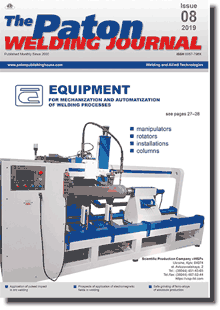| 2019 №08 (02) |
DOI of Article 10.15407/tpwj2019.08.03 |
2019 №08 (04) |

The Paton Welding Journal, 2019, #8, 12-17 pages
Journal The Paton Welding Journal
Publisher International Association «Welding»
ISSN 0957-798X (print)
Issue #8, 2019 (September)
Pages 12-17
Investigation of interaction of Ni3Al-based alloy with interlayers of different alloying systems for TLP-bonding
V.V. Kvasnytskyi1, G.F. Myalnitsa2, M.V. Matviienko3, E.A. Buturlya4 and Dong Chunlin5
1National Technical University of Ukraine «Igor Sikorsky Kyiv Polytechnic Institute» 37 Peremohy Prosp., 03056, Kyiv, Ukraine. E-mail: kvas69@ukr.net
2SE «Scientific-Production Gas Turbine Construction Complex «Zorya»–«Mashproekt» 42a Oktyabrskyi Prosp., 54018, Mykolaiv, Ukraine
3Kherson Branch of Admiral Makarov National University of Shipbuilding 44 Ushakova Prosp., 73022, Kherson, Ukraine
4Admiral Makarov National University of Shipbuilding 9 Heroiv Ukrainy Prosp., 54025, Mykolaiv, Ukraine
5Guangdong Provincial Key Laboratory of Advanced Welding Technology, Guangdong Welding Institute (China-Ukraine E.O. Paton Institute of Welding), Guangzhou, 510650, China
Fusion welding of cast high-temperature nickel alloys with high content of strengthening disperse phases is problematic. Even more serious problem is welding of intermetallic-based materials. Therefore, different methods of brazing are widely used for such materials joining. TLP-bonding (Transient Liquid Phase Bonding) is a term which has the most often application abroad. Considering that brazing filler materials have lower melting temperature than base metal, the concentration of depressants (reducing brazing filler metal melting temperature) in a brazed weld shall be reduced to the minimum in order to increase working temperature of brazed joints in brazing process. The depressants of high-temperature brazing filler metals are divided on several groups. Interaction of Ni3Al-based alloy with brazing filler metals containing silicon, boron, zirconium and hafnium was investigated in the work. SBM-3 brazing filler metal of Ni–Cr–Co–Al–Ti–Ta–Re–W–Mo–Hf–B system was developed based on investigations results. 17 Ref. , 7 Figures.
Keywords: brazing, nickel alloys, strengthening phase, depressants, brazing filler metal development, melting temperature
Received: 14.06.19
Published: 24.09.19
References
1. Krivtsun, I.V., Kvasnytskyi, V.V., Maksymov, S.Yu., Yermolayev H.V. (2017) Special methods of welding: Manual. Ed. by B.E. Paton. Mykolaiv, NUK [in Ukrainian].2. Yermolayev H.V., Kvasnytskyi, V.V., Kvasnytskyi, V.F. et al. (2015) Brazing of materials: Manual. Ed. by V.F. Khorunov, V.F. Kvasnytskyi. Mykolaiv, NUK [in Ukrainian].
3. Kablov, E.N. (2012) Strategic tendencies in development of materials and technologies of their processing for period up to 2030. Aviats. Materialy i Tekhnologii, 5, 24-30 [in Russian].
4. Kablov, E.N., Ospennikova, O.G., Bazyleva, O.A. (2011) Materials for high-loaded parts of gas turbine engines. Vestnik MGTU. Seriya Mashinostroenie, 9, 13-19 [in Russian].
5. Buntushkin, V.P., Kablov, E.N., Kachanov, E.B., Shalin, R.E. (1994) High-temperature structural materials based on intermetallic Ni3Al. In: Aircraft materials at the turn of the XX-XXI centuries: Sci.-Techn. Transact. Moscow, VIAM [in Russian].
6. Buntushkin, V.P., Kablov, E.N., Bazyleva, O.A., Morozova, G.I. (1999) Alloys based on nickel aluminides. Metallovedenie i Termich. Obrab. Metallov, 1, 32-34 [in Russian]. https://doi.org/10.1007/BF02466270
7. Lukin, V.I., Rylnikov, V.S., Afanasiev-Khodykin, A.N. (2012) Peculiariries of brazing single-crystal castings and alloy ZhS32. Svarochn. Proizvodstvo, 5, 24-30 [in Russian].
8. Lukin, V.I., Rylnikov, V.S., Afanasiev-Khodykin, A.N. (2010) Peculiaries of producing of ZhS36 alloy brazed joint. Tekhnol. Mashinostroeniya, 5, 21-35 [in Russian].
9. Lukin, V.I., Rylnikov, V.S., Afanasiev-Khodykin, A.N., Timofeeva, O.B. (2013) Peculiarities of diffusion brazing technology of high-temperature alloy EP 975 and cast single-crystal intermetallic alloy VKNA-4U applying to structure «Blisk». Svarochn. Proizvodstvo, 7, 19-25 [in Russian].
10. Xiong Yue, Fengmei Liu, Hexing Chen, et al. (2018) Effect of Bonding Temperature on Microstructure Evolution during TLP Bonding of a Ni3Al based Superalloy IC10. ICCEMS 2018, MATEC Web of Conferences 206, 03004. https://doi.org/10.1051/matecconf/201820603004
11. Malashenko, I.S., Kurenkova, V.V., Belyavin, A.F., Trokhimchenko, V.V. (2006) Short-term strength and microstructure of brazed joints of alloy VZhL12U produced using boron-containing brazing alloy with addition of silicon. Sovrem. Elektrometall., 4, 23-38 [in Russian].
12. Malashenko, I.S., Mazurak, V.E., Kushnareva, T.N. et al. (2014) Vacuum brazing of cast nickel alloy ZhS6U with composite brazing alloys on VPr-36 base. Pt 1. Ibid., 4, 49-58 [in Russian].
13. Kvasnytsky, V.F., Kostin, A.M., Kvasnitsky, V.V. (2002) Influence of elements-depressants on properties of nickel brazing filler metals and high-temperature alloys. Adgeziya Rasplavov i Pajka Materialov, 35, 129-139 [in Russian].
14. Maksymova, S.V., Voronov, V.V., Kovalchuk, P.V. (2017) Brazing filler metal without boron and silicon for brazing of heat-resistant nickel alloy. The Paton Welding J., 8, 12-17. https://doi.org/10.15407/tpwj2017.08.02
15. Kvasnitskiy, V.V., Timchenko, V.L., Ivanchenko, V.G., Khorunov, V.F. (1998) The investigation of Ni(Nialloy)-Hf-Cr system for heat-proof nickel alloy brazing. DVS-Berichte: Band 192, Duesseldorf:DVS - VERL, 262-264.
16. Kvasnitskiy, V.V., Timchenko, V.L., Ivanchenko, V.G., Khorunov, V.F. (1998) Die Untersuchung des System Ni(Niliq)-Hf-Zr- fuer das Loten warmfester Nickellegierungen. Ibid., 257-259 [in German].
17. Kvasnitskiy, V.V. (1998) Composite filler metal brazing of heat-proof nickel alloys. Ibid., 260-262.
18. Khorunov, V.F., Ivanchenko, V.G., Kvasnitskiy, V.V. (1998) Investigation of systems Ni-Cr-Zr and Ni-Cr-Hf alloys. Ibid., 59-61.
19. Myalnytsa, G.P., Maksyuta, I.I., Kvasnitska, Yu.G., Mykhnyan, O.V. (2013) Selection of alloying complex of new corrosion-resistant alloy for nozzle blades of GTE. Metaloznavstro ta Obrobka Metaliv, 2, 29-34 [in Ukrainian].
